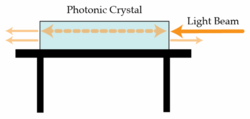One-dimensional Photonic Crystal
 Photonic crystals are materials which have dielectric constant which varies periodically, thus creating many interesting phenomena. One-dimensional photonic crystals are made from parallel layers with varying dielectric constants. We can analyze the unit cell of such crystals by examining the effect a single dielectric crystal has on a beam of light.
Photonic crystals are materials which have dielectric constant which varies periodically, thus creating many interesting phenomena. One-dimensional photonic crystals are made from parallel layers with varying dielectric constants. We can analyze the unit cell of such crystals by examining the effect a single dielectric crystal has on a beam of light.
Suppose light enters the glass crystal in the image above from the right. Some percentage of the light will exit from the left and some from the right. The transmission coefficient at the air/glass interface is , and is the same in both directions. How much of the light in % exits the crystal on the left?
The answer is 53.85.
This section requires Javascript.
You are seeing this because something didn't load right. We suggest you, (a) try
refreshing the page, (b) enabling javascript if it is disabled on your browser and,
finally, (c)
loading the
non-javascript version of this page
. We're sorry about the hassle.
Let the intensity of light entering from right be I .
But due to air-glass interface only 0.7 I will enter the crystal from right.
therefore 0.7 I will reach the other end (on the left side).
Again it will face an air-glass interface. therefore, 0 . 7 × 0 . 7 I will exit on the left and 0 . 3 × 0 . 7 I will rebound and travel towards the right side.
again upon reaching the right end (air-glass interface) 0 . 3 × ( 0 . 3 × 0 . 7 I ) will rebound and travel towards left.
this process repeats infinitely thus forming an infinite geometric progression whose first term will be 0 . 7 × 0 . 7 I and common ratio = 0 . 3 × 0 . 3 = 0.09
thus summing the series will give:
1 − 0 . 0 9 0 . 7 × 0 . 7 I
= 0.5384 I
converting it to % gives 53.84% hence the answer..